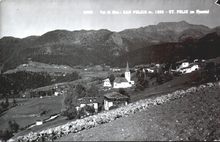St. Felix (South Tyrol)
St. Felix ( Italian: San Felice ) is a village in South Tyrol and, together with Our Lady in the Forest, one of the two fractions of the community of Our Lady in the Walde-St. Felix .
The place is in the upper Val di Non at an altitude of 1250 m slm . A little east of the village, which is counted as part of the Deutschnonsberg due to its German-speaking population , is the Felixer Weiher ( Lago di Tret in Italian ) at 1605 m slm .
Brief historical overview
Until the beginning of the 19th century, St. Felix was called Caseid (Italian "casetta" = small house, small settlement), which was first mentioned in 1223 in connection with a certain Vitus de Vasio (from Vasio Castle, between Fondo and Brez ). The current name only gradually became established through the church of St. Felix of Nola . St. Felix only became an independent community in 1864 when it was separated from Our Lady in the Forest .
Until the end of the First World War, St. Felix belonged to the County of Tyrol and thus to Austria-Hungary . With the Treaty of Saint-Germain in 1920, the village came to Italy together with most of Tyrol south of the main Alpine ridge . When the two provinces of Bolzano and Trento emerged in these formerly Austrian territories in 1927, St. Felix and the other communities of the Deutschnonsberg were added to the predominantly Italian-speaking province of Trento. It was not until 1948 that the village was incorporated into the province of Bozen and South Tyrol. From 1952 to 1974 the community was ruled by the following mayors: Alois Geiser (1952–1956), Johann Weiss (1956–1957), Franz Geiser (1957–1964) and Johann Weiss (1964–1974). In 1974 St. Felix merged with Our Lady in the Forest to form a common congregation.
In legal terms, St. Felix belonged to the District Court of Fondo until 1964 , and in 1970 it came to the District Court of Merano.
Ecclesiastically, St. Felix originally belonged to the parish Fondo and was given a curate in 1723. In 1693 the cemetery of St. Christoph (about two kilometers from St. Felix) was given to the Caseidern by the provost of the Gries monastery. From 1723 to 1824 St. Felix was always looked after by Italian curates.
The parish church of St. Felix was built in 1742, a tower followed in 1758 and in 1902 the church was renovated.
The church of St. Christoph was built around 1500 in place of an older church that was described as having existed long ago in 1476.
The patronage ("Felix day", as this holiday is called in the village) is celebrated on the last Sunday in August.
literature
- John W. Cole, Eric R. Wolf : The Hidden Frontier. Ecology and Ethnicity in an Alpine Valley , New York & London, Academic Press, 1974 (1999 with a new introd.); German: The invisible border. Ethnicity and ecology in an alpine valley . Folio-Verlag, Vienna-Bozen 1995.
- Margareth Lanzinger, Edith Saurer (ed.): Inequality on the border. Historical and anthropological search for traces in the Alpine region: Tret and St. Felix. Edition Raetia, Bozen 2010, ISBN 978-88-7283-373-5 .
Web links
Individual evidence
- ↑ The mayors of the South Tyrolean municipalities since 1952. (PDF; 15 MB) In: Festschrift 50 Years of the South Tyrolean Association of Municipalities 1954–2004. Association of South Tyrolean municipalities, pp. 139–159 , accessed on November 16, 2015 .
Coordinates: 46 ° 30 ' N , 11 ° 8' E


